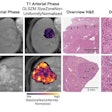Friday, December 6 | 10:30 a.m.-10:40 a.m. | SST07-01 | Room E351
Dedicated 7-tesla MRI of the female pelvis shows the feasibility and potential of in vivo, ultrahigh-field pelvic imaging, which could help clinicians more accurately diagnose pelvic parenchymatous and vasculature disease, according to a study from Germany.Dr. Thomas Lauenstein, from Essen University Hospital, and colleagues included 14 healthy women in the study, using a custom-built eight-channel MRI radiofrequency body coil. The exam protocol included T1-weighted fat-saturated 2D fast low-angle shot (FLASH), T1-weighted fat-saturated 3D FLASH, and T2-weighted turbo spin echo.
Two radiologists assessed each exam's visualization of pelvic anatomy, vasculature, tissue contrast, and overall image quality, using a five-point scale (with a score of 1 equal to nondiagnostic visualization and a score of 5 meaning excellent visualization).
For the T1-weighted sequences, 2D FLASH imaging had higher scores for all assessed structures than 3D FLASH MRI, with overall image quality receiving the highest scores. T2-weighted turbo-spin echo imaging produced a moderate to high visualization of the anatomy of the uterus.
Seven-tesla MRI is a feasible way to visualize the female pelvis in finer detail, the team concluded.




.fFmgij6Hin.png?auto=compress%2Cformat&fit=crop&h=100&q=70&w=100)




.fFmgij6Hin.png?auto=compress%2Cformat&fit=crop&h=167&q=70&w=250)











